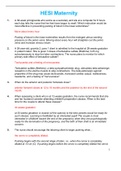Samenvatting
BSc Social Sciences - Economy and Society - Year 2 Summary
- Instelling
- Vrije Universiteit Brussel (VUB)
This summary covers the full information written in Prof. Vermeiren's book. It is, in other words, a fully-written summary of the chapters he teaches in class, and requires as mandatory reading. With this summary alone, I received a 15/20 for his exam. Disclaimer: any information from the slides i...
[Meer zien]










